1. Yoo J, Lee E, Kim C, Lee J, Lixing L. Sasang constitutional medicine and traditional Chinese medicine: a comparative overview. Evid Based Complement Alternat Med. 2012; 2012:980807. PMID:
21941592.

2. Kim JY, Pham DD. Sasang constitutional medicine as a holistic tailored medicine. Evid Based Complement Alternat Med. 2009; 6 Suppl 1:11–19.

3. Shin S, Kim YH, Hwang MW. Diagnosis and treatment principle in Sasang medicine: original symptom. Integr Med Res. 2016; 5:99–104. PMID:
28462103.

4. Lee J, Jung Y, Yoo J, Lee E, Koh B. Perspective of the human body in sasang constitutional medicine. Evid Based Complement Alternat Med. 2009; 6 Suppl 1:31–41.

5. Kim JY, Kim CW, Koh BH, Song IB. Justification and usage of food classification according to body constitution. J Sasang Const Med. 1995; 7:263–279.
6. Lee CH. Health concept in traditional Korean diet, in therapeutic use of foods in East Asia. Korean Korean Am Stud Bull. 1998; 9:8–18.
7. Lee CH. Harmonization of eastern and western health knowledge; nutrigenetics and Sasang typology. Food Sci Technol Res. 2007; 13:89–95.

8. Lee J, Lee J, Lee E, Yoo J, Kim Y, Koh B. The Sasang constitutional types can act as a risk factor for hypertension. Clin Exp Hypertens. 2011; 33:525–532. PMID:
21958429.

9. Cho NH, Kim JY, Kim SS, Lee SK, Shin C. Predicting type 2 diabetes using Sasang constitutional medicine. J Diabetes Investig. 2014; 5:525–532.

10. Lee SK, Yoon DW, Yi H, Lee SW, Kim JY, Shin C. Tae-eum type as an independent risk factor for obstructive sleep apnea. Evid Based Complement Alternat Med. 2013; 2013:910382. PMID:
23554836.

11. Choi K, Lee J, Yoo J, Lee E, Koh B, Lee J. Sasang constitutional types can act as a risk factor for insulin resistance. Diabetes Res Clin Pract. 2011; 91:e57–e60. PMID:
21146241.

12. Lee SK, Yoon DW, Lee SW, Kim JY, Kim JK, Shin C. Non-alcoholic fatty liver disease among sasang constitutional types: a population-based study in Korea. BMC Complement Altern Med. 2015; 15:399. PMID:
26547840.

13. Lee TG, Koh B, Lee S. Sasang constitution as a risk factor for diabetes mellitus: a cross-sectional study. Evid Based Complement Alternat Med. 2009; 6 Suppl 1:99–103.

14. Moon HJ, Jung SJ. Nursing approach of four constitutional theory. J Korea Community Health Nurs Acad Soc. 1996; 10:139–154.
15. Kim YY, Choue R, Song IB, Lee EJ. The clinical effect of Sasang constitutional diets for the hypercholesterolemic patients. Korean J Nutr. 2000; 33:824–832.
16. Yang M, Lee HS, Hwang MW, Jin M. Effects of Korean red ginseng (Panax Ginseng Meyer) on bisphenol A exposure and gynecologic complaints: single blind, randomized clinical trial of efficacy and safety. BMC Complement Altern Med. 2014; 14:265. PMID:
25063041.

17. Choi JH, Pichiah PB, Kim MJ, Cha YS. Cheonggukjang, a soybean paste fermented with B. licheniformis-67 prevents weight gain and improves glycemic control in high fat diet induced obese mice. J Clin Biochem Nutr. 2016; 59:31–38. PMID:
27499576.
18. Kang SJ, Seo JY, Cho KM, Lee CK, Kim JH, Kim JS. Antioxidant and neuroprotective effects of Doenjang prepared with
Rhizopus,
Pichia, and
Bacillus. Prev Nutr Food Sci. 2016; 21:221–226. PMID:
27752498.
19. Wu WJ, Lee HY, Lee GH, Chae HJ, Ahn BY. The antiosteoporotic effects of Cheonggukjang containing vitamin k2 (menaquinone-7) in ovariectomized rats. J Med Food. 2014; 17:1298–1305. PMID:
25259841.

20. Lee SY, Park SL, Hwang JT, Yi SH, Nam YD, Lim SI. Antidiabetic effect of Morinda citrifolia (Noni) fermented by Cheonggukjang in KK-A(y) diabetic mice. Evid Based Complement Alternat Med. 2012; 2012:163280. PMID:
22969823.
21. Lee DH, Kim MJ, Ahn J, Lee SH, Lee H, Kim JH, Park SH, Jang YJ, Ha TY, Jung CH. Nutrikinetics of isoflavone metabolites after fermented soybean product (Cheonggukjang) ingestion in ovariectomized mice. Mol Nutr Food Res. 2017; 61.

22. Kim MJ, Lee DH, Ahn J, Ha TY, Jang YJ, Do E, Jung CH. A pilot study on characteristics of metabolomics and lipidomics according to Sasang constitution. Evid Based Complement Alternat Med. 2018; 2018:9214960. PMID:
30002718.

23. Lee SJ, Park SH, Cloninger CR, Kim YH, Hwang M, Chae H. Biopsychological traits of Sasang typology based on Sasang personality questionnaire and body mass index. BMC Complement Altern Med. 2014; 14:315. PMID:
25164072.

24. Kim SH, Lee Y, Koh BH, Jang E. Assessing the diagnostic accuracy of the questionnaire for Sasang constitutional classification II (QSCC II): a systematic review. Eur J Integr Med. 2013; 5:393–398.

25. Kim EJ, Choue R, Song IB. The food classification in Sasang constitution and effects of Tae-um constitutional diet on the blood biochemical parameters and health status. Korean J Nutr. 1999; 32:827–837.
26. Lee DH, Kim MJ, Song EJ, Kim JH, Ahn J, Nam YD, Jang YJ, Ha TY, Jung CH. Nutrikinetic study of genistein metabolites in ovariectomized mice. PLoS One. 2017; 12:e0186320. PMID:
29059247.

27. Coll AP, Farooqi IS, O'Rahilly S. The hormonal control of food intake. Cell. 2007; 129:251–262. PMID:
17448988.

28. Shin D, Jeong D. Korean traditional fermented soybean products: Jang. J Ethn Food. 2015; 2:2–7.
29. Lee BH, Kwon KB, Han JH, Ryu DG. Bibliographical study on the constitutional foods in Korean medicine. Korean J Orient Physiol Pathol. 2009; 23:1207–1220.
30. Atkinson C, Frankenfeld CL, Lampe JW. Gut bacterial metabolism of the soy isoflavone daidzein: exploring the relevance to human health. Exp Biol Med (Maywood). 2005; 230:155–170. PMID:
15734719.

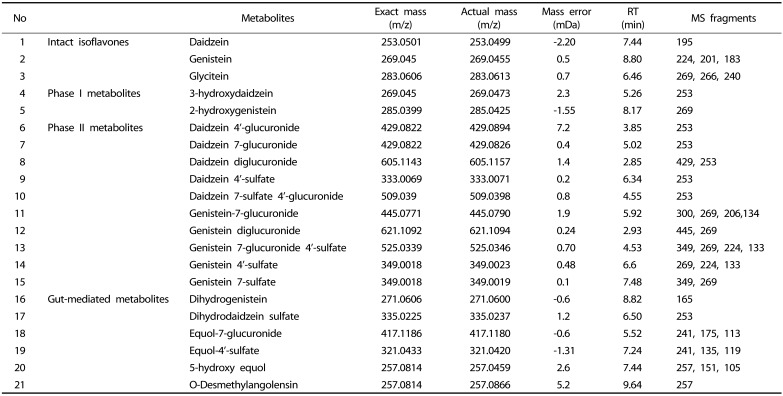
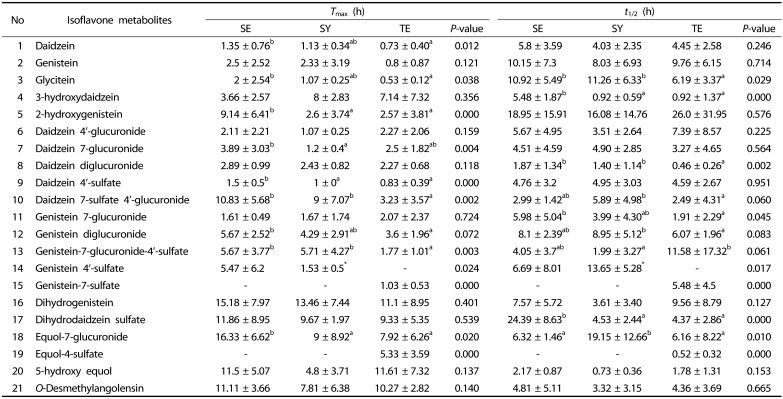
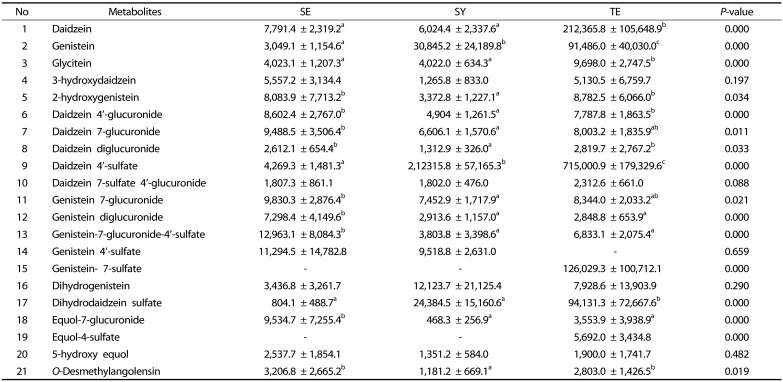
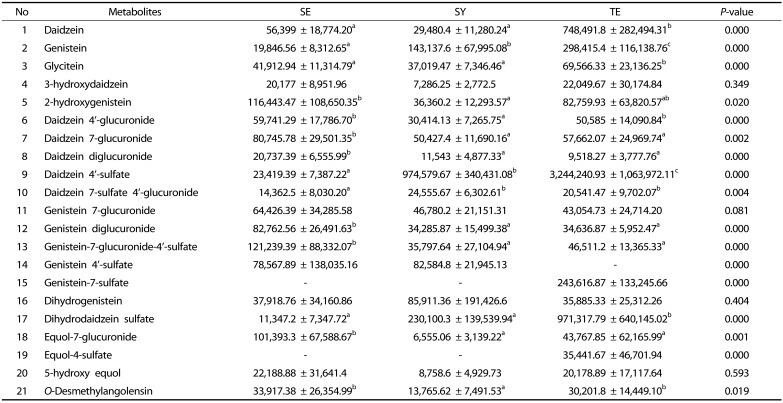
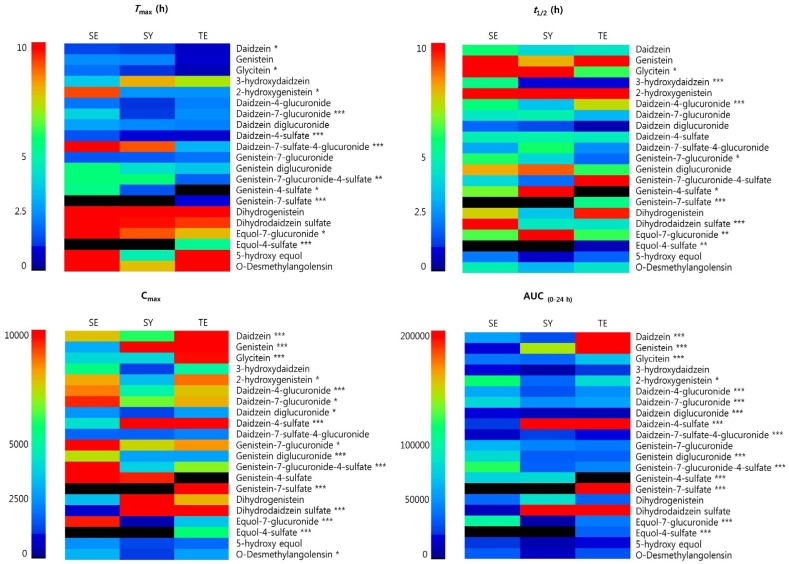




 PDF
PDF ePub
ePub Citation
Citation Print
Print



 XML Download
XML Download